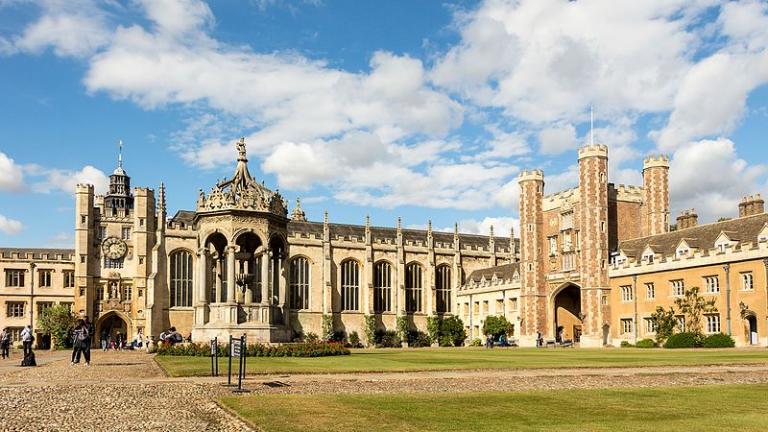
(Wikimedia Commons public domain image)
***
First of all, I’ve just become aware that Edward Idris Cardinal Cassidy passed away a week ago today, 10 April 2021, at the age of 96. I had the privilege of meeting with Cardinal Cassidy on two separate occasions, once in Rome (or, more precisely, in Vatican City) and once in Sydney, Australia, after he had retired from his service in the Vatican. He was — he is — a genial, kind, and open-minded man, and I respect him very much. I’ll have some more to say about him, and about my two experiences with him, in a day or two.
***
Continued from “The Man Who Knew Infinity (Part One)”:
I carry on now with notes taken from (and/or inspired by) Robert Kanigel, The Man Who Knew Infinity: A Life of the Genius Ramanujan (New York and London: Washington Square Press, 1991):
In the 1930s, E. T. Bell would remark that Ramanujan had broken the rules by which mathematicians evaluate their own. “When a truly great [algorist, or formalist] like the Hindu Ramanujan arrives unexpectedly out of nowhere, even expert analysts hail him as a gift from heaven,” he wrote, crediting him with “all but supernatural insight” into hidden connections between seemingly unrelated formulas.
Supernatural insight.
A gift from Heaven.
It is uncanny how often otherwise dogged rationalists have, over the years, turned to the language of the shaman and the priest to convey something of Ramanujan’s gifts. . . . And repeatedly they have been reduced to inchoate expressions of wonder and awe in the face of his powers, have stumbled about, groping for words, in trying to convey the mystery of Ramanujan.
“We have no idea how he did the marvelous things he did, what led him to them, or anything else,” says mathematician Richard Askey, a Ramanujan scholar at the University of Wisconsin in Madison. Says Bruce Berndt, after years of working through Ramanujan’s notebooks: “I still don’t understand it all. I may be able to prove it, but I don’t know where it comes from and where it fits into the rest of mathematics.” He adds at another point, “The enigma of Ramanujan’s creative process is still covered by a curtain that has scarcely been drawn.” (280)
J. E. Littlewood essentially surrenders in perplexity when trying to understand Ramanujan’s thought processes:
There is, indeed, a touch of real mystery [here]. If only we knew [the result in advance], we might be forced, by slow stages, to the correct form of [Psi sub q, symbols that I can’t reproduce on this blog]. But why was Ramanujan so certain there was one? Theoretical insight, to be the explanation, had to be of an order hardly to be credited. Yet it is hard to see what numerical instances could have been available to suggest so strong a result. And unless the form of [Psi sub q] was known already, no numerical evidence could suggest anything of the kind — there seems no escape, at least, from the conclusion that the discovery of the correct form was a single stroke of insight. (Cited at 280-281)
To borrow terminology suggested by the Polish emigré mathematician Mark Kac, Ramanujan was actually a “magician,” rather than an “ordinary genius”:
An ordinary genius is a fellow that you and I would be just as good as, if we were only many times better. There is no mystery as to how his mind works. Once we understand what he has done, we feel certain that we, too, could have done it. It is different with the magicians. They are, to use mathematical jargon, in the orthogonal complement of where we are and the working of their minds is for all intents and purposes incomprehensible. Even after we understand what they have done, the process by which they have done it is completely dark. (Cited at 281)
Kanigel reacts to such statements in a striking way:
Mystery, magic, and dark, hidden workings inaccessible to ordinary thought; it is these that Ramanujan’s work invariably conjures up, a sense of reason butting hard up against its limits.
But at reason’s limits does something else take over? Do we here flirt with spiritual or supernatural forces outside our understanding? (281)
Ramanujan himself plainly thought so. Kanigel cites reminiscences from fellow-Indians who knew him:
T. K. Rajagopolan, a former accountant general of Madras, would tell of Ramanujan’s insistence that after seeing in dreams the drops of blood that, according to tradition, heralded the presence of the god Narasimha, the male consort of the goddess Namagiri, “scrolls containing the most complicated mathematics used to unfold before his eyes.”
R. Radhakrishna Iyer, a classmate at Pachaiyappa’s College, recalled one day asking Ramanujan about his research only to have him reply, in Radhakrishna’s words, “that Lord Narasimha had appeared to him in a dream and told him that the time had not come for making public the fruits of his research.”
And it was on a day about a year before he left for England, in 1912 or early 1913, that Ramanujan, showing his work to mathematics professor R. Srinivasan, made the statement in which he pictured equations as products of the mind of God. (281-282)
Some, though — starting with Ramanujan’s zealously atheistic mathematical mentor, the great G. H. Hardy — have sought to downplay or even to dispute Ramanujan’s deep spirituality:
[M]ost Western observers, and some Indians, have wholly detached Ramanujan’s mystical streak from his mysterious ability to forge new mathematical linkages. Hailing the one, they’ve dismissed the other. (283)
Kanigel thinks that they are wrong to do so but, in the end, he too — a Western rationalist — wants to make Ramanujan’s creativity purely internal, psychological. He believes that the Indian’s credulity opened his mind in a unique way to intuition, to his own unconscious. Even G. H. Hardy was open, just a little tiny bit and rather reluctantly, to a role for the subconscious in mathematical thinking. But Kanigel isn’t quite sure of his own position:
But it was Hardy, the dedicated atheist, who represented the extreme position, and Ramanujan who was more in line with the large body of belief and conviction, within the Western tradition as well as that of the East, that perceived links between creativity and intuition on the one hand and spiritual forces on the other.
The Greeks, for example, invoked the muses — goddesses to whom poets looked for inspiration. Both the English and French languages speak of “divining” the truth. (286-287)
Just as India was not alone in attributing creative insights to divine influence, Ramanujan was not alone among mathematicians in holding strong religious beliefs. Newton was an unquestioning believer, felt humility in the face of the universe’s wonders, studied theology on his own. [The great eighteenth-century Swiss mathematician Leonhard] Euler, in E. T. Bell’s words, “never discarded a particle of his Calvinistic faith,” and grew more religious as he grew older. [The famous early-nineteenth-century French mathematician Augustin-Louis] Cauchy was forever trying to convert other mathematicians to Roman Catholicism. [The nineteenth-century French mathematician Charles] Hermite had a strong mystical bent. Even Descartes, that father of Enlightenment rationality, answered the call of the spirit: “His religious beliefs were unaffectedly simple in spite of his rational skepticism,” writes Bell. “He compared his religion, indeed, to the nurse from whom he had received it, and declared that he found it as comforting to lean upon one as on the other.” (287)
But, of course, the issue isn’t merely whether mathematicians can “hold strong religious beliefs.” Obviously they can do so, and sometimes they actually do. Ramanujan, however, wasn’t merely religious. He believed that his mathematical insights came to him by revelation. And he has company, in that regard:
Even among mathematicians not religiously minded, one finds evidence of at least respectful allusion to the dark terrain between faith and reason. [The preeminent nineteenth-century German mathematician Carl Friedrich] Gauss, for example, once proved a theorem, as he wrote, “not by dint of painful effort but so to speak by the grace of God.” James Hopwood Jeans, Hardy’s Cambridge classmate and a famous applied mathematician, wrote: “From the intrinsic evidence of his creation, the Great Architect of the Universe now begins to appear as a pure mathematician.” Even Littlewood, commenting on an incident in which “my pencil wrote down” the solution to a particularly bedeviling problem, could write, “If we may reject divine bounty, it happened exactly as if my subconsciousness knew the thing all the time.” Littlewood’s, of course, was the usual safe, ironic Cambridge skepticism, perhaps no more than a stylistic device — just as the other statements may be seen as no more than metaphor, Yet each contained the barest breath of ambivalence or humility in the face of the mysterious origins of human creativity. (287-288)
[Another excellent example that might have been included here is that of Blaise Pascal. I’ll write and post something about his case fairly soon. Perhaps also Henri Poincaré, if I’m not misremembering.]
There is much to think about here: A Latter-day Saint perspective would certainly allow, and perhaps insist on, the likelihood of genuinely prompting divine revelation in such cases.
And there is matter to think about not just on that particular subject: Robert Kanigel explicitly raises one question in this next paragraph, about the great loss suffered by mathematics because Ramanujan went so long without adequate mathematical education and because he died so very, very young, and indirectly suggests another: Isn’t it astonishing that purely theoretical mathematical ideas that have been worked out in isolation by a genius who knew nothing about chemistry, computers, or oncology can be found relevant to those fields (and others) decades after his death? This is precisely the issue raised by the famous 1960 essay “The Unreasonable Effectiveness of Mathematics in the Natural Sciences” by the Hungarian-American theoretical physicist Eugene Wigner, who would go on to win the 1963 Nobel Prize in Physics.
Writes Kanigel:
“Srinivasa Ramanujan,” an Englishman would later say of him, “was a mathematician so great that his name transcends jealousies, the one superlatively great mathematician whom India has produced in the last thousand years.” His leaps of intuition confound mathematicians even today, seven decades [now almost exactly 101 years] after his death. His papers are still plumbed for their secrets. His theorems are being applied in areas — polymer chemistry, computers, even (it has recently been suggested) cancer — scarcely imaginable during his lifetime. And always the nagging question: What might have been, had he been discovered a few years earlier, or lived a few years longer? (3)
Another question that Ramanujan’s story raises is, How many geniuses — with enormous gifts not only for mathematics but for business and literature and law and physics and statecraft and art and genetics and medicine and economics and scores of other fields — go utterly unrecognized, are lost in poverty, die too early, leaving their enormous potential untapped and even unknown? And what cures for cancer were lost at Bergen-Belsen and Dachau? What great novels and plays were snuffed out in the Gulag or the Cambodian “killing fields” before their authors ever put pen to paper or, perhaps, even conceived them? What contributions to science and art, literature and government, commerce and medicine have been lost in abortion clinics?
Thus Kanigel:
It is a story of one man and his stubborn faith in his own abilities. But it is not a story that concludes, Genius will out — though Ramanujan’s, in the main, did. Because so nearly did events turn out otherwise that we need no imagination to see how the least bit less persistence, or the least bit less luck, might have consigned him to obscurity. In a way, then, this is also a story about social and educational systems, and about how they matter, and how they can sometimes nurture talent and sometimes crush it. How many Ramanujans, his life begs us to ask, dwell in India today, unknown and unrecognized? And how many in America and Britain, locked away in racial or economic ghettos, scarcely aware of worlds outside their own? (3-4)
And, finally, on the question of whether mathematical facts or objects really objectively exist, of whether mathematicians “invent” them or “discover” them — Ramanujan plainly sided with those who believe them to be objectively real — G. H. Hardy offered a strikingly strong statement of what seems to be a realist position. In a 1928 Cambridge lecture, he said the following:
I have always thought of a mathematician as in the first instance an observer, a man who gazes at a distant range of mountains and notes down his observations. His object is simply to distinguish clearly and notify to others as many different peaks as he can. There are some peaks which he can distinguish easily, while others are less clear. He sees A sharply, while of B he can obtain only transitory glimpses. At last he makes out a ridge which leads from A, and following it to its end he discovers that it culminates in B. B is now fixed in his vision, and from this point he can proceed to further discoveries. In other cases perhaps he can distinguish a ridge which vanishes in the distances, and conjectures that it leads to a peak in the clouds or below the horizon. (cited at 285)
It seems, as was suggested in Part One of this entry, almost a religious vision. I’m happily inclined to believe that G. H. Hardy was religious, or spiritual, in his own way, as Srinivasa Ramanujan certainly was. May God bless them both.
Posted from Park City, Utah












